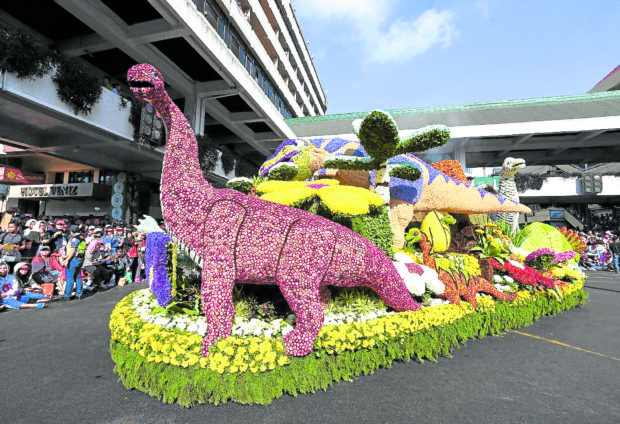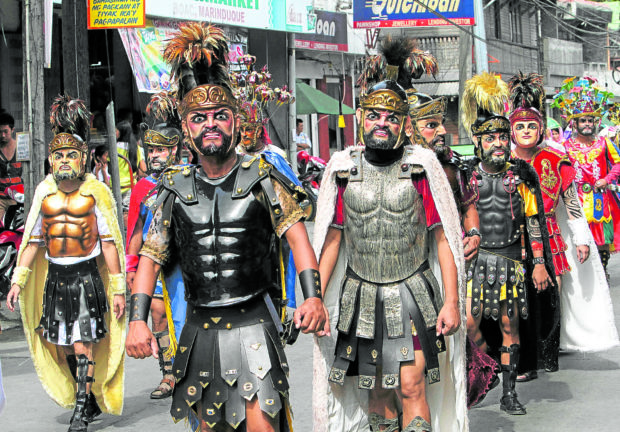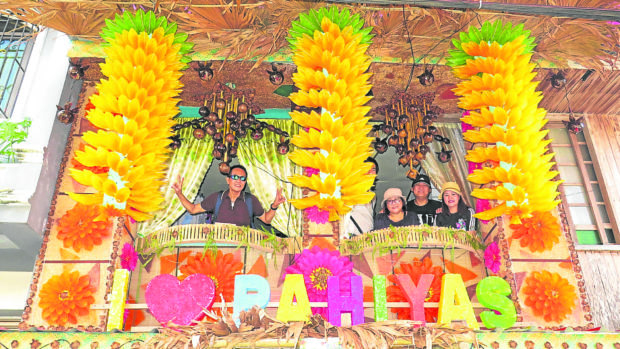Virus takes luster off PH festivals
(First of two parts)
Landscape artist Myrna Frago was looking forward to this year’s Anilag Festival in Laguna province after she was tapped by San Pablo City officials to design and create the local government’s 21-square-meter booth for the fair in the capital town of Sta. Cruz.
“We had to prepare months ahead. We hired laborers to collect the materials like bamboo and wood from the mountains,” she said.
Anilag Festival, coined from “ani ng Laguna” (harvest of Laguna), is held in March to showcase the products of Laguna’s 24 towns and six cities. It is also a competition for the best and most creative booth that local governments are willing to spend hundreds of thousands of pesos to dress up their entries.
But as with any government transaction, Frago was ready to shell out her own money, confident that she could collect her fees after the event. “We already finished about a third [of the booth] and already spent about P100,000,” she said.
But Frago was not prepared for the festival’s last-minute cancellation because of the new coronavirus disease (COVID-19) pandemic. She was left with a mounting debt to a hardware store and a closed bank checking account.
Cultural showcase
Frago’s plight is similar to thousands who benefit from the staging of crowd-drawing community festivals to help promote local products, culture and natural attractions. Though held only once a year, these events feature other activities that give local businesses and entrepreneurs opportunities to earn from tourist traffic.
Local governments have been forced to stop the staging of festivals and other events starting February, when the number of COVID-19 cases started to climb in the country. The decision followed health protocols laid out by the national government to prevent the transmission of the coronavirus.
The crisis also led to community lockdowns and travel restrictions that virtually killed tourism for the first half of the year. At least 65 festivals, including local government events, scheduled from February to June, had been canceled, or postponed around the country.
Even before the Luzon-wide lockdown in March, the specter of COVID-19 had already become the worst nightmare for central and northern Luzon communities that thrive on summer festivals and other tourism-related activities.
As early as February, various events were canceled, beginning with Baguio City’s Panagbenga (Baguio Flower Festival) and Pangasinan’s Limgas na Pangasinan beauty pageant that would have been staged alongside the Pista’y Dayat (Sea Festival) celebration.
Lost opportunities
The lost opportunities from mothballed events were staggering, and swept immediately through almost every economic sector in many towns.
“Festival season is harvest time for artists, such as choreographers, performers, wardrobe designers and makeup artists,” said Childe Libertad, a Pangasinan college instructor who sidelines as a pageant director.
His team was about to screen beauty title aspirants when virus fears forced the provincial government to cancel the sea festival.
Dagupan City Mayor Brian Lim also scrapped the Bangus Festival. “Many industries benefit from the festival like ‘bangus’ (milkfish) producers who grow the fish specifically for the festival, and now have to find new markets for them,” he said.
Twenty-three festivals and 28 town fiestas scheduled from February to June are no longer happening in Pangasinan, said Malu Amor-Elduayan, the provincial tourism officer.
No estimates had yet been made as to economic losses but the scrapping of the Pista’y Dayat alone cost hotels and restaurants, suppliers and those in the creative industry P50 million in potential revenue.
When the Araw ng Kagitingan (Day of Valor) ceremony was called off on April 9 at Mt. Samat Memorial Shrine in Pilar, Bataan province, losses ran up to P6.2 million, including estimated sales from a trade fair, according to the Department of Tourism (DOT) in Central Luzon.
In Nueva Ecija province, the lockdown forced residents to abandon their religious and agriculture-based festivals. The government and local businesses in San Jose City lost a combined P7.8 million when the Pagibang Damara Festival, usually held in April, was canceled.
In Pampanga province, revenue was lost when the Lubao International Balloon and Musical Festival was canceled, also in April. The three-day event used to get P1.2 million in budget support and ticket sales from 40,000 to 50,000 visitors, according to the DOT.

SUMMER FUN GONE The coronavirus pandemic has forced local governments to either scrap or postpone annual crowddrawing cultural and religious festivals, many of these held during summer. Among the events canceled this year are the Moriones of Marinduque, Pahiyas of Quezon, Bangus Festival of Dagupan City and Panagbenga of Baguio City. —PHOTOS BY DELFIN MALLARI JR., WILLIE LOMIBAO AND EV ESPIRITU
Quezon’s ‘Pahiyas’
In Quezon, tourism-dependent businesses are losing millions of pesos due to the pandemic.
The Pahiyas Festival that put Lucban, Quezon, on the list of must-see summer fiestas, was also canceled. The May 15 festival honors San Isidro de Labrador, patron saint of farmers, and is known for displays of multicolored “kiping” (rice wafers arranged like chandeliers), vegetable and fruit harvests, and other native products in every house along the procession route.
“I pity most of my townmates. Difficult days are coming after the pandemic,” said Milada Dealo-Valde, former president of Quezon’s tourism council and a bakeshop owner. She asked the government to provide local businesses tax relief to offset their losses.
Rimberto Veloso, owner of one of native sausage makers in Lucban, said: “We used to sell more than P1 million worth of longganisa during the Pahiyas week. But now with COVID-19 around, we expect around 68 percent of our annual volume sales gone.”
Considered “nonessential” during a public health crisis, tourism is the first to lose public and private budget allocation, but probably the last of the sectors to reopen once the pandemic eases out, said Sylvia Marasigan, head of the Batangas Tourism and Culture Office.
Big event for Limasawa
In the Visayas, this year’s Sinugdan Festival in the historic island of Limasawa, Southern Leyte province, was meant to be the “dry run” for next year’s 500th anniversary of the first Mass in Asia.
Its staging on March 31 was canceled, to the disappointment of organizers who were expecting 4,000 guests, said Remigilda Salomon, Limasawa tourism officer. The event, she said, would have given local hotels, restaurants and fair exhibitors opportunities to earn.
Visayan festivals like the Paraw Regatta boat sailing festival in Iloilo (Feb. 23); Battle of Mactan in Lapu-Lapu City, Cebu (April 27); Panaad sa Negros Festival in Negros Occidental (April 20); Indang Festival in Hindang town, Leyte (May 8); and Saulog Festival in Tagbilaran City, Bohol (May 1) were scratched.
Junel Ann Divinagracia, Iloilo City tourism officer, said some hotels were coping with the slump by accommodating thousands of employees of business process outsourcing firms who are being housed by their companies amid travel restrictions.
“Our operations are certainly very far from normal and are down by 80 to 90 percent. We are also focused on helping our employees financially and to make sure they stay healthy,” said Happy Abenir, spokesperson for the Iloilo Hotels, Resorts and Restaurants Association.
While tourism was not in good shape, cancellation remained a better option in the wake of COVID-19, said Carlo Suarez, president of the Hotel, Resort and Restaurant Association of Cebu.
“If these festivals pushed through, it would be dangerous for the people especially that we have an unseen enemy here,” he said.
In Negros Occidental, festivals, which are mostly held in summer, have been canceled, said Jennylind Cordero, the provincial acting tourism officer.
She said displaced workers in the tourism sector would be needing livelihood assistance and new tourism approaches would have to be planned.
Festivals could turn virtual, or smaller and scaled down in the future to avoid mass gatherings, Cordero said.
Beach party
The cancellation of Mindanao’s largest summer beach party, the Sarangani Bay (SarBay) festival, scheduled from May 28 to May 30, was a big blow to beach resorts and other local tourism players, said April Marjorie Rudes, Sarangani provincial tourism officer.
“[There’s no] money lost, only [lost] opportunities for local businesses,” Rudes said.
Last year, the three-day festival earned some P68 million in tourism receipts. It generated some 1,100 jobs for locals who earn money as extra resort workers, marshals, cleaners, security, food servers and event organizers.
The village of Gumasa, nicknamed “Boracay of the South” for its white sand beaches, would have hosted the festival’s 13th staging this year.
“As excited as we all are, we prioritize your health and security. Our prayer is for everyone’s best and we can’t wait to see you all in 2021,” Gov. Steve Solon said in a statement.
—REPORTS FROM MARICAR CINCO, DELFIN MALLARI JR., TONETTE OREJAS, YOLANDA SOTELO, VINCENT CABREZA, CARLA GOMEZ, NESTOR BURGOS JR., ADOR VINCENT MAYOL, JOEY GABIETA, BONG SARMIENTO AND ROMMEL REBOLLIDO


